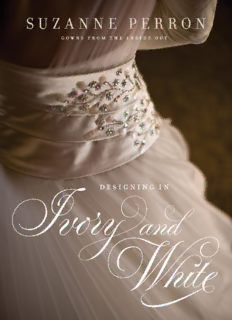
Designing in Ivory and White: Suzanne Perron Gowns from the Inside Out PDF
Preview Designing in Ivory and White: Suzanne Perron Gowns from the Inside Out
Ivory White designing in and Ivory de s i g n i n g i n and White su z a n n e p e r r o n Gowns from the Inside Out photographs by jason cohen and brian baiamonte louisiana state university press baton rouge Published by Louisiana State University Press Copyright © 2012 by Louisiana State University Press All rights reserved Manufactured in China First printing designer: Michelle A. Neustrom typefaces: Whitman, text; Filosofia and Parfumerie Script Pro, display printer and binder: Regent Publishing Services Note: Photographers are identified by initials in the captions. Credits for photographs without captions are as follows: Brian Baiamonte: page viii Jason Cohen: frontispiece, pages vi, xiv, 40, 48, 132 library of congress cataloging-in-publication data Perron, Suzanne, 1968– Designing in ivory and white : Suzanne Perron gowns from the inside out / Suzanne Perron ; photographs by Jason Cohen and Brian Baiamonte. p. cm. ISBN 978-0-8071-4370-4 (cloth : alk. paper) — ISBN 978-0-8071-4371-1 (pdf) — ISBN 978-0-8071-4372-8 (epub) — ISBN 978-0-8071-4373-5 (mobi) 1. Perron, Suzanne, 1968– —Themes, motives. 2. White. I. Cohen, Jason, 1983– II. Baiamonte, Brian, 1972– III. Title. TT505.P375A5 2012 646.476—dc23 2011029994 The paper in this book meets the guidelines for permanence and durability of the Committee on Production Guidelines for Book Longevity of the Council on Library Resources. (cid:1)(cid:1) For Ruth Hackett East and Caroline East Perron, in appreciation of their never-ending support and inspiration Contents foreword, by susan langenhennig ix preface xi introduction: the designer 1 the couture process 23 the client experience 41 the gowns 51 Jolie, Bride 57 Jackye, Olympians Queen 63 Shelley, Bride 69 Emily, Athenians Queen 75 Jackye, Achaeans Maid 81 Lauren, Bride 87 Sarah, Rex Maid 91 Francesca, Harlequins Queen 95 Jenny, Bride 101 Kelly, Rex Maid 105 Emily, Rex Maid 111 Ainsley, Bride 115 Eleanor, Olympians Queen 121 Connie, Bride 127 Lauren, Bride 133 Suzanne, Bride acknowledgments 137 Foreword T he world comes in standard sizes these days. Small, medium, large. Six, eight, ten. Petite, tall, misses. We pull a garment off the rack at the local mall or at our favorite bou- tique, slip into it in the dressing room, and admire a reasonable approximation of fit—though the waist may gape slightly and the legs may drag the floor. When we’re lucky, it works enough, especially with a little tailoring. If the dress skims our curves and the pants fall appropriately, we head to the checkout counter. The majority of us shop this way, whether our tastes and budgets run to Dil- lards or Dolce & Gabbana, whether we’re looking for work clothes, play clothes, or a dress for a special event. Modern lives require the efficiency that comes from mass production. Everything moves in a hurry. But, in our fast-paced world, is there still a place for couture—the art of intri- cately designed, custom-fitted, hand-finished clothing? Boiled down to its most basic elements, couture is custom. It’s a one-of-a-kind, a perfect fit designed by an artist for an individual. If you’re reading this in your home, take a quick glance around the room and stop to think how many things around you were designed to your specific preferences, wants, and desires. How many were created to fit just you? In our off-the-shelf culture, such intimacies are rare pleasures indeed. Couture—often lamented as the endangered species of the fashion industry— survives, hanging on to its antique ways—the sketches, the draping, the muslin, the hand-sewing, the multiple fittings—even as the world zips by it with the speed of an online shopping click. Asked in a 2007 New York Times interview why couture was still relevant to his business—which includes ready-to-wear and accessories—designer Alber Elbaz of Lanvin replied, “I think it’s important to still support couture because we’re sup- porting a technique, a dream.” “It’s a big question you are asking,” he continued. “Do you keep the past by going forward, or do you have to maintain it in order to exist?” Suzanne Perron is a gifted designer, helping to establish a vibrant, albeit small, fashion industry in Louisiana. She’s doing it in the most traditional of ways. And that seems so fitting for New Orleans, a city that in the early part of the twenty- first century is both leading the country in young entrepreneurship and previously untried school reform and yet still rooted within our venerable cultural traditions of Carnival and cotillions. ix
Description: